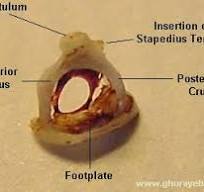Which is the smallest bone in the human body?

In the intricate framework of the human body, where complexity meets elegance, lies a mystery waiting to be unraveled: which is the smallest bone in the human body. The stapes, located in the middle ear, is the smallest bone in the human body. While often overlooked amidst the grandeur of its larger counterparts, this diminutive yet mighty bone boasts an array of features that defy its size. Tucked away within the intricate architecture of the ear, this marvel of nature serves as a cornerstone of our auditory prowess. As we embark on this journey of discovery, we peel back the layers of anatomy to reveal the hidden gem nestled within the labyrinth of bones.
With each revelation, we not only gain insight into the features of this petite yet powerful bone but also uncover the advantages it bestows upon us. From its intricate structure to its crucial role in auditory function, the smallest bone exemplifies the ingenuity of biological design and the remarkable efficiency of nature’s creations. As we delve deeper into its anatomy and physiology, we uncover the benefits it offers, from facilitating sound transmission to contributing to our sense of balance and spatial awareness.
Anatomical Basics
Understanding the Human Skeletal System
At the core of our physical structure lies the skeletal system, a framework of bones that provides support, protection, and mobility. From the sturdy femur to the delicate phalanges, each bone plays a vital role in maintaining the integrity of the body.
The Significance of Bones in the Body’s Structure and Function
Beyond their structural role, bones serve as reservoirs of minerals, producers of blood cells, and anchors for muscles and ligaments. The intricate interplay between bones, muscles, and joints allows for graceful movement and precise coordination, highlighting the indispensable nature of the skeletal system.
The Quest for the Smallest Bone
In the realm of anatomy, size is not always a straightforward metric. When it comes to bones, factors such as length, width, and mass all contribute to the perception of ‘smallness.’ However, in the case of the smallest bone in the human body, the sheer diminutiveness sets it apart from its larger counterparts.
Challenges in Identifying the Smallest Bone in the human
The quest to pinpoint the smallest bone is not without its challenges. The human body boasts over 200 bones, each intricately interwoven with its neighbors, making it a daunting task to isolate the tiniest among them. Additionally, variations in bone size among individuals further complicate the search for the elusive smallest bone.
Factors Influencing Bone Size
From genetic predispositions to environmental factors, a myriad of influences shape the size and morphology of bones. Understanding these factors not only sheds light on the intricacies of skeletal development but also provides valuable insights into the evolutionary adaptations that have sculpted the human body over millennia.
An Overview of the Auditory System
Nestled within the temporal bone of the skull lies the auditory system, a marvel of biological engineering responsible for the complex process of hearing and balance. Comprising delicate structures such as the ear canal, eardrum, and cochlea, the auditory system plays a crucial role in our sensory perception of the world.
The Role of Bones in Hearing and Balance
Central to the function of the auditory system are the ossicles, a trio of tiny bones located within the middle ear. These bones—namely the malleus, incus, and stapes—act as amplifiers, transmitting sound vibrations from the eardrum to the inner ear, where they are converted into neural signals and interpreted by the brain. In addition to facilitating hearing, the ossicles also play a key role in maintaining balance and spatial orientation.
Introducing the Stapes: The Smallest Bone in the Human Body
Amidst the intricate architecture of the middle ear, one bone stands out for its diminutive size: the stapes. Also known as the stirrup bone, the stapes measure a mere 2.5 to 3 millimeters in length, earning it the coveted title of the smallest bone in the human body.
Location, Structure, and Function of the Stapes
Situated between the incus and the fenestra ovalis of the inner ear, the stapes resemble a miniature stirrup, with a head, neck, and two crura extending downward like legs. Despite its minuscule size, the stapes play a crucial role in the transmission of sound waves, amplifying vibrations and transmitting them to the fluid-filled cochlea.
Comparing the Size of the Stapes to Other Bones
While the stapes may be the smallest bone in the human body, its significance extends far beyond its diminutive stature. Comparisons with other bones, such as the femur or the ulna, highlight the remarkable diversity of size and shape within the skeletal system, underscoring the adaptive nature of human anatomy.
Examining the Significance of Bone Size in Relation to Function
Despite its small size, the stapes exemplify the principle of form following function—a concept deeply ingrained in the field of anatomy. By maximizing surface area and minimizing mass, the stapes achieves optimal efficiency in its role as a sound conductor, demonstrating the remarkable efficiency of biological design.
Common Conditions Affecting the Stapes
Despite its importance in hearing and balance, the stapes are not immune to pathology. Conditions such as otosclerosis, congenital malformations, and trauma can compromise the function of the stapes, leading to hearing loss, vertigo, and other symptoms.
Treatment Options for Stapes-Related Issues
Fortunately, advances in medical science offer a range of treatment options for stapes-related issues. From surgical interventions such as stapedectomy to non-invasive techniques like hearing aids and vestibular rehabilitation, modern medicine provides solutions to help restore function and improve the quality of life for individuals affected by stapes pathology.
Historical Discoveries About the Stapes
The stapes have captured the attention of scientists and scholars throughout history, with notable figures such as Leonardo da Vinci and Andreas Vesalius documenting their structure and function in their anatomical studies. These early observations laid the groundwork for our modern understanding of the auditory system and the role of the stapes within it.
Cultural and Symbolic Significance of the Stapes
Beyond its physiological importance, the stapes hold cultural and symbolic significance in various societies around the world. From ancient myths and folklore to contemporary art and literature, references to the stapes abound, serving as a reminder of the enduring fascination with the mysteries of the human body.
Highlighting Other Small Bones in the Human Body
While the stapes may claim the title of the smallest bone in the human body, it is by no means the only diminutive member of the skeletal system. From the tiny bones of the fingers and toes to the delicate structures of the inner ear, the human body is replete with small bones, each with its own unique role and significance.
Their Roles and Significance in Anatomy and Physiology
Despite their small size, these tiny bones play crucial roles in anatomy and physiology. Whether providing support and mobility or serving as attachment points for muscles and ligaments, these diminutive structures contribute to the overall function and integrity of the skeletal system, underscoring the importance of every bone, regardless of size.
Tracing the Evolutionary History of the Stapes
The evolutionary origins of the stapes can be traced back millions of years to the ancestors of modern mammals. Through comparative anatomy and paleontological evidence, scientists have pieced together the evolutionary lineage of the stapes, shedding light on its adaptive significance and evolutionary development over time.
Comparing Stapes Across Different Species
While the stapes may be a hallmark of mammalian anatomy, variations in size, shape, and structure can be observed across different species. From the elongated stapes of whales and dolphins to the modified stapes of birds and reptiles, comparative studies offer insights into the diversity of auditory adaptations found in the animal kingdom.
The Future of Stapes Research
As technology continues to advance, so too does our understanding of the stapes and its role in auditory function. From high-resolution imaging techniques to genetic analyses, researchers are pushing the boundaries of stapes research, uncovering new insights into its development, function, and pathology.
Potential Implications for Medical Science and Technology
The insights gleaned from Stapes research hold promise for the future of medical science and technology. From the development of novel treatments for hearing loss to the design of innovative hearing aids and cochlear implants, discoveries related to the stapes have the potential to revolutionize the field of auditory medicine and improve outcomes for patients worldwide.
Conclusion
As we conclude our exploration of the smallest bone in the human body, we are reminded of the remarkable complexity and elegance of the human anatomy. From its minuscule size to its profound impact on auditory function, the stapes serve as a testament to the ingenuity of biological design and the enduring mysteries of the human body.
As we bid farewell to the stapes and its remarkable story, let us not forget the countless other mysteries that await discovery within the human body. By nurturing a spirit of curiosity and inquiry, we can continue to unlock the secrets of our anatomy and marvel at the wonders that lie within.









